[Updated: 7/24, 7:34am]

Photo: Ethan Jewett
By now, everyone’s heard of the “Velib” bike-sharing program launched by Paris earlier this month.
That program — whose name so poetically is formed from the French words for “bike” and “liberty” — placed 10,600 bikes at 750 stations for use by Parisians and tourists alike who want a cheap (first half-hour is free, day pass is $1.36), healthy, fun and earth-friendly way to see the city.
But there’s a buzz about bike-sharing that goes way beyond Paris. Cities all over Europe already have successful systems in place and even a few American cities have jumped on the bike-sharing bandwagon (New York City being the latest).
Here in Portland, talk about a bike-sharing system has been making the rounds since early this year. Last week, these informal discussions took a significant step forward when the official request for proposals (RFP) was released by Commissioner Sam Adams’ office.
The RFP description says Portland wants to,
“Evaluate the possibility of hiring a Contractor to operate a public bicycle rental service…The City is seeking proposals from firms, teams or contractors interested in the delivery and operation of a bicycle fleet for rent to the general public and stationed in the public right of way to further promote the City’s use of a multi-modal public transportation system with a focus on the City’s core area.”
Adams’ Senior Policy Director for Transportation issues Roland Chlaplowski (photo, right) says all the applications to manage the service must be in by mid-September. At that time, he’ll form an evaluation committee to help select a contractor (if you’re interested in being on that committee email rchlapowski@ci.portland.or.us).
In a conversation today, I expressed concern to Chlaplowski that access to a bike wasn’t the reason people chose to not ride downtown and I questioned whether bike-sharing would succeed in Portland.
Would easy access to a bike make up for the fact that many Portlanders simply don’t feel safe on our downtown bike lanes and other routes?
Chlaplowski agreed that a safe bike network is key, but he pointed out that current efforts to improve bike safety downtown would make bikes a more viable option and would eventually increase the number of potential riders.
One of those efforts is the city’s focus on planning for low-traffic bike boulevards (like the one slated for NW Flanders and another yet-to-be determined north/south route).
He also pointed out that if/when TriMet ever discontinues their “fareless square” service, than that would increase potential for use of a bike-sharing system.
Chlapowski — who said he’d use the system on days when he leaves his bike at home — thinks it’s worth the investment because it would be a perfect way to encourage newbies to try biking with little to no risk,
“It allows someone who might not be a regular biker to do it a little… it can prime the pump in getting non-riders to give biking a try. People will realize that a bike is the most efficient way to make their trip… it will give folks that option to do it risk-free and cheap.”
Portland’s RFP asks for a mix of potential stations that would emphasize both work/commute/shopping trips with recreational use. The list of potential station locations includes: colleges, Waterfront Park, transit stations, and Pioneer Courthouse Square.
As for funding, Chlapowski says that would depend on which business model is preferred by the chosen contractor. He says in Lyon, France (a model Sam Adams is very familiar with), the public subsidy is small due to advertising revenue (on the bikes) and user fees.
Any gap in costs between the revenue generated from the system and what it takes to operate would be covered by PDOT. Chlapowski expects that gap to be small, but added that PDOT would “find the funds” when the time comes.
Will bike-sharing work in Portland?
Chlapowski is the first one to admit it’s by no means a sure thing. But like I’ve mentioned many times in recent weeks, if we truly want to become what city bike coordinator Roger Geller refers to as a “world class bike city in an American context” we’ve got to be willing to take some bold steps.
It’s worth pointing out that the Oregonian Editorial Board gave a huge thumbs-up to bike-sharing in their Sunday edition (7/22). I’d link to it but it’s not online.


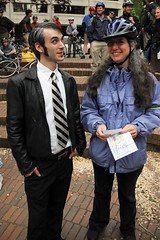
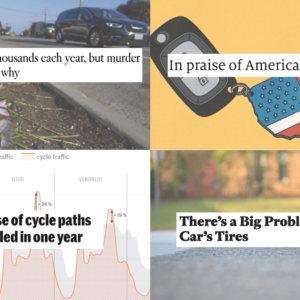
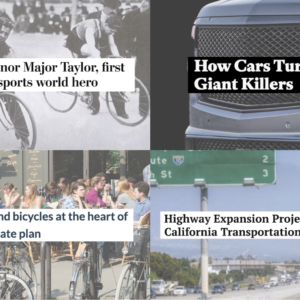
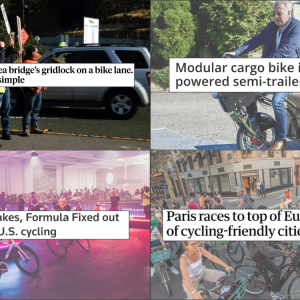
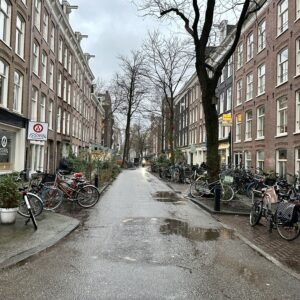
Thanks for reading.
BikePortland has served this community with independent community journalism since 2005. We rely on subscriptions from readers like you to survive. Your financial support is vital in keeping this valuable resource alive and well.
Please subscribe today to strengthen and expand our work.
I\’m curious about helmet availability at bike stations like this. I\’d love to make bikes available to anyone that wants to ride one but I also would like to see them wear helmets or at least have the option to do so if they enjoy using their brain. Is that in the plan anywhere? I remember seeing these stations in Denmark but I don\’t recall seing any kind of helmet options.
I\’m sorry, but bike boulevards are not the universal cure, and neither bike boulevards nor bike lanes work very well in downtown.
Waffle King: No, you didn\’t see any provision for helmet sharing in Denmark. If you didn\’t notice, no one in Denmark wears a helmet to ride a bike. This is because they consider riding a bike to be a normal activity, rather than a high risk thrill ride. Strangely enough, if you actually look at the figures for bicycle related injury in Denmark, they seem to be right. Here in America, of course, anyone renting or lending a bike without strictly requiring that a helmet be worn with it would be opening themselves up for a ruinous lawsuit. Don\’t worry, if such a poroigram is implemented, you won\’t need to remind anyone about these things; the lawyers will be there, and there will be waivers to be signed, you bet.
The folks undertaking planning for the Arlington/ DC project are struggling with the helmet issue too.
I would suggest setting the minimum user age to that point where state law does not require a helmet (16?) and thus not require helmets for users.
The operators could decide to integrate a \’smart carte\’ type locker holding helmets next to the bikes – for rider who wants one. Or only providing helmets at bike kiosks near a bike shop (partner). Or leaving it up to the frequent user to BYOH (bring your own helmet).
The provision of helmets adds another barrier to use, hurdle for maintenance (do you provide 2 or 3 helmets in different sizes per bike), location siting (do you increase the bulk of the kiosk, so that it now takes up more street space), cost, etc.
A note from Dave Brook:
There are a couple of revealing shots in this French Tv news report about the JC Decaux public bike system in Paris.
http://www.youtube.com/watch?v=kzDzZVIxmTA&mode=related&search=
I do think that this would be pretty neat; but I also have doubts about it\’s functionality considering how unsafe most Portlanders feel riding downtown. At the same time I do think simply having more people on bikes makes the road safer (and feel safer) So if people did start using them then the perception of bikes as unsafe might begin to change. I can see people using this on their lunch break and taking trimet. That would be pretty neat.
I hope to see the bike sharing program in PDX in the near future. I think bike sharing is a great idea in general, BUT I also agree that the safety infrastructure has to increase for it to be a success in PDX. Bike lanes and Bike Blvd\’s are also a good idea, the problem is they haven\’t yet been implemented properly. They only exist where and to the extent that they are convenient to motorists. We need to begin to treat bike transport as at least an equal if not the most preferred mode of transit.
Waffle King, I\’d say comment #4 offers a far more balanced reasoning of why Denmark probably doesn\’t have helmets available for use at bike stations than does comment #3.
Some people are also going to have some anxiety about wearing a helmet commonly used by the public, but maybe this situation isn\’t that much different than renting skates, bowling shoes, or bicycle helmets when you rent a bike on the prom.
I\’m not sure I see why bike boulevard\’s have to be a universal cure in order to derive some realistic benefit from them in a metropolitan area whose future is directed towards higher density. It kind of seems like anything that offers some relief from auto gridlock and promotes encouragement of a healthy mode of transportation such as cycling, inline skating,or skateboarding should be made as welcome as possible. Especially on weekends, in outlying neighborhoods as well as downtown, this idea seems doable without compromising auto access to those areas too much.
Pardon the rambling post, but I think I\’m on to something here…
Bike rental downtown would be great for tourists, business travelers and transit riders who occasionally need to zip across town for a meeting or an errand. It would serve essentially the same purpose as Flexcar, but it would be much cheaper and more eco-friendly, it would be easier/cheaper to find parking, and it would cost a lot less. Heck, I\’d use it occasionally on days when I ride the bus in to work because it\’s just too nasty and wet in the AM.
But nobody has mentioned the suburbs…
Consider how a system like this could change commuting to/from the \’burbs if there were a few dozen of these bikes at every MAX station.
Imagine: get off the MAX (in Beaverton, Hillsboro, at Tackamas Clown Center, in Hollywood) and grab a bike. Then ride it to a return station by the front door of wherever you work (think Intel, Nike, Norm Thompson, various hospitals, etc.). During the day, anyone at your campus could use it to zip around between buildings. Then, at the end of your workday, grab any one of the bikes out front and ride it back to the MAX station.
Then, with most of the bikes back at the MAX station by 5:30 or so, suburban-dwelling commuters coming home at end of the workday would have a bike (with a warm seat, no less…) waiting at the station for them, to ride home to their eco-burb.
This would require \”hitching posts\” at three location-types: MAX stations; major employment sites; and suburban residential areas (apartment complexes, \”towne\” centers, etc.)
Major employment centers in the burbs have been struggling to increase transit ridership ever since the MAX went in, and this seems like it could help a lot, both to bring people TO the MAX, and to distribute people into the burbs FROM the MAX.
And TriMet would be happy, since they wouldn\’t have as many people complaining about all the \”greasy bikes\” on MAX.
Wait, there\’s more! Similar stations could be set up at every \”Park and Ride\” and at the new Commuter Line between Beaverton and Wilsonville. The \”last leg\” of lots of transit riders is currently taken by car; many of them could switch to riding bikes instead.
-Steve
Val, I agree, it is strange enough to look at Denmark\’s bike accident statistics.
If \”Velolib\” stood for Velo-Library, then
Portland would already have one. The People\’s Bike Library of Greater Portland,
also known as The Pile, maintained by ZooBomB, located across from
Roccos. Come on over Sunday nite and \”Check one out\”. –RyNO–
I disagree that riding downtown is unsafe. This is a matter of perception, not fact. I find downtown one of the safest places in town to ride, mostly due to the relatively slow (~15 mph) traffic speeds.
Installing more bike lanes downtown is a terrible idea that would actually increase, rather than decrease, the risk of cycling downtown if current engineering designs (think SW Broadway) are used.
Oslo has a cool bike rental program. I was there for 1 day earlier in the month. I counted bikes for a couple of hours and 1/3 of the bikes I saw being ridden were rentals. I wanted to try it out but you needed to get a card and I wasn\’t sure how to do that. Hopefully any installation in portland will have instructions in many languages so visitors can easily use them too.
Bjorn who wishes he spoke better Norwegian…
The perception that riding in downtown PDX is dangerous, is real. If that\’s a reason many people don\’t give it a try, then listen to them and find ways to cure their apprehensions. You can make a point to the contrary as much as you want (BURR #12), but until the gas guzzlers get on board with what we\’re trying to do here, nothing will change. One day it would be great to actually see motor vehicles disappear from downtown due to not just going by way of bicycle themselves, but because it\’s too slow for them to follow behind all the cyclists. The bike sharing thing sounds great, but we need better infrastructure to accomodate everyone first.
This seems odd to me, given the city recently began charging flexcar for all their on-street parking spaces, essentially removing the subsidy for car-sharing…yet the city is willing to subsidize bike sharing? seems pretty in-consistent to me
I agree that their needs to be other infrastructure (and in my opinion a cultural change may also be necessary) before this will be super effective; however, it seemse to me that we have to start somewhere and this is a fair place to start. Right now I don\’t think we\’re putting the cart before the horse. I think we have just begun thinking about what kind of cart to buy.
I just don\’t see it working, even though I think it\’s super neato.
Downtown Portland is too small to require a bike for most tourists, and TriMet/walking does a decent job of getting folks around already. I don\’t think most tourists or residents would rent a bike to leave downtown with steep hills on one side and long traffic congested inclines on the other. Think Fort Stevens – concentrated purpose specific trails, but still I think most cyclists bring their own bikes, instead of renting *conjecture*. It\’s a totally different set up. It would take a different style of cosmopolitan or rural environment for a bike rental system to work here.
Do the bikes come with U-locks so the renter can lock up at a destination? Even though the design of the bike is to help decrease theft, I simply don\’t trust any unlocked bike situation.
As much as I\’d love to see it, motoring downtown isn\’t going away anytime soon. Ever since ODEQ lifted the downtown parking \’lid\’, the city has steadily increased the amount of parking for motorists in the downtown core, starting with the Fox Tower garage. That means more cars and more congestion, not less.
#17 The way the system worked in oslo there were somewhere around 40 different rack locations with maps on every rack. The idea was to swipe your card, grab a bike and then leave it at another rack. There were definately times when we wanted to go from one rack spot to another that was 1-3 miles away where I would have rented the bike if I could have.
Bjorn
Bjorn – That makes sense, having a lot of racks so the renter could go hither and thither with a ton of options (do we have that many attractive destination options in Portland? One in front of Sassy\’s, one in front of Mary\’s…isn\’t that what most non-family tourists do? and what about families? are there going to be kid accessories?)
Does this sound likely to anyone – Portland puts in a few racks, they don\’t get used an awful lot in the first year or so, and then it\’s called a failure and dropped with the addition of increased anti-tax anti-bike anti-anti fallout?
I think it would be great if we took a Sao Paulo approach, and took radical steps to close off car traffic and force people to use mass transit/bikes/feet, but not even the most liberal AND electable politician is going to take the bull by the horns and force change – which I don\’t think is really possible with our government – for one person or group to force radical change, that is. (Which is usually a good thing.)
Without trying to sound overly pessimistic, we\’re a few years away from being able to really utilize a bike rental program.
I would love to be proven wrong.
Yeah, the way they hand out parking garages like candy does make a huge statement that our priorities are alittle askew. Two steps forward one step sideways…the only way these bicycle pipe-dreams will ever come to fruition, is if the city takes a stand and sticks to it.
the city appears to think that they can keep cramming more of everything – bikes, cars, busses, light rail – onto the downtown streets. at some point, this policy is going to reach critical mass and fail dramatically.
streetcar, too. the streetcar expansion has a huge potential for future negative impacts to the biking environment and should be watched very closely and very critically.
Portland needs at least one \”great\” street for biking downtown.. a street that\’s visually stunning, connects to desirable destinations and incredibly safe.. something that would be welcoming to even non-cyclists. That might increase the use of such a program, if it were to go forward.
I think that a good bit of the perception about whether bicycling in traffic is unsafe has to do with how quick, strong, and experienced in cycling commenting on the topic are. Same with the reality.
If you can keep up with the traffic without knocking yourself out, and still have energy to look back or in your mirror frequently, signal, switch lanes effectively, and all the other things you have to do as a cyclist to be safe amongst cars, well then, it probably seems safe to you.
If a person is a former cyclist kind of out of shape, or a newbie being encouraged to give cycling a shot, consider that the traffic issue could be a major intimidation factor, translating to the unspecific conclusion that biking is unsafe. Ideas like bike boulevards that essentially maximize safety for cyclists of a wide range of conditioning and experience would probably counter this one negative conclusion on the part of some people to the idea of cycling.
I appreciate y\’alls love for bike boulevards, but bike boulevards only work in certain limited circumstances, and connectivity is still needed. Sometimes that will be a bike lane, but many times it will require a shared lane situation, which sharrows or other tools would facilitate. the city really needs more \’tools in their toolbox\’; one or even two treatments won\’t apply in all situations, why is PDOT still resisting the use of sharrows and other techniques that have shown promise and likely have utility in Portland???
SteveG — Thats what its all about.
That would be the ideal situation for a sustained local bike rental program.
Tourists could also benefit from such a program as well. Also consider people from out of town that might be avid cyclists at home but are there for business and were unable to bring their bike with them. Get a little free time, grab a bike and take ride.
http://www.bicyclefrenzy.com